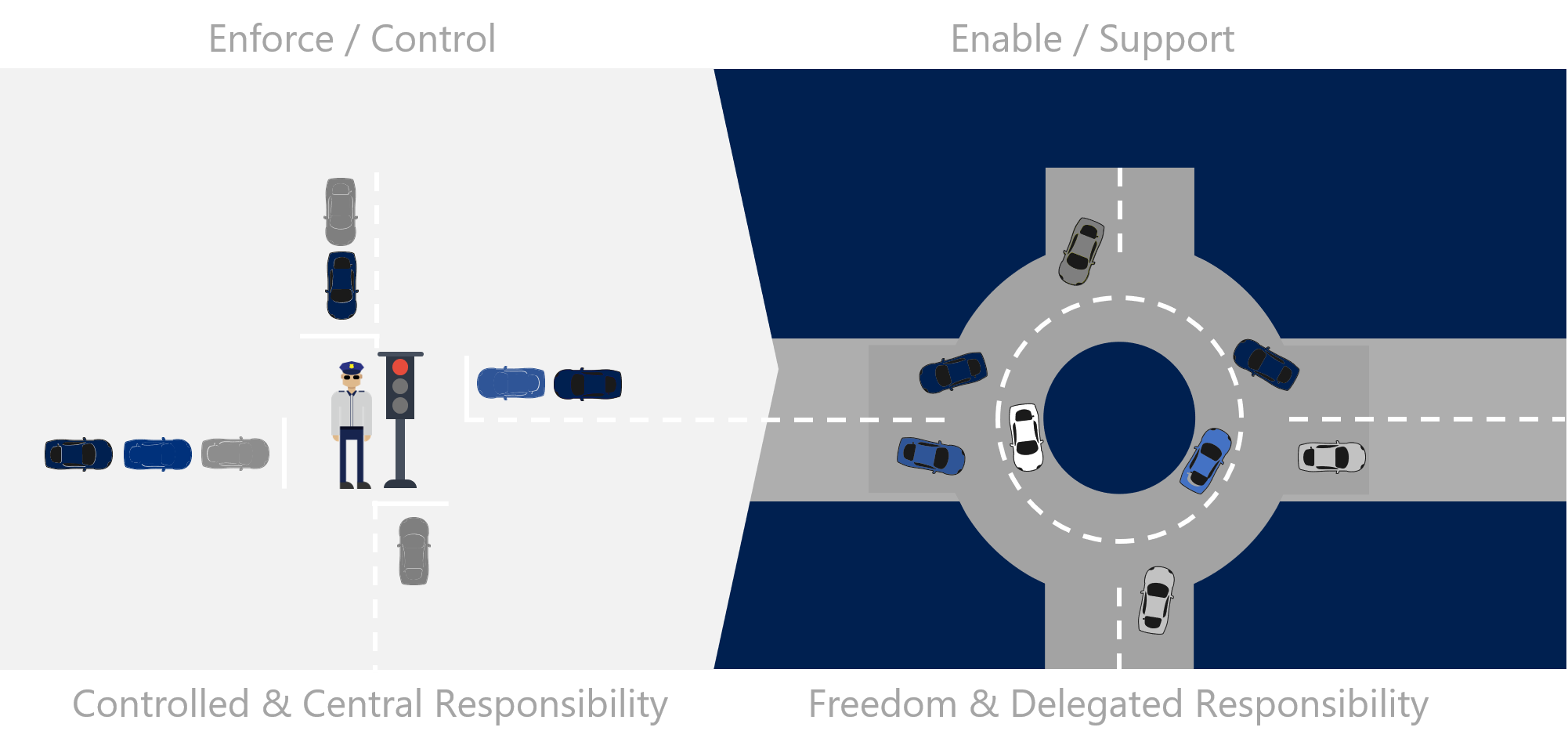Why do companies fail when adapting to the cloud? Simply the lack of foreshadowing. Some companies think only about the cost-saving and elastic benefits the cloud provides but forget that people and governance are where it really starts. Others might see that competitors are using the cloud and they are falling behind, thus they must migrate/deploy resources in the cloud “yesterday”. As a result, the cloud journey could be costly, but mainly poorly managed.
A company who plans for tomorrow, are often the ones who have established a Cloud Center of Excellence (CCoE). It really doesn’t matter what you call this team, but it should be a team that is tasked with the responsibility of developing a framework of standards for the company’s cloud operations.

How to build a Cloud Center of Excellence team
The idea is that every company with a presence in the cloud—no matter what its size—should have a team with the overall responsibility. This idea is just like a DevOps mindset, of building a company-wide understanding by breaking down the silos within a company. Cloud Center of Excellence should have the responsibility of adding/updating/improving policy-driven governance, role-based access, and most of all keeping the backbone a well-oiled machine. If this is done correctly, it should provide a beginning point for adopting innovative technologies quicker and removing blockers that are often seen when adapting to the cloud.
Designing CCoE
I find the best way to start is by having a pizza. If you like pizza like I do, then you know it’s better to have pizza with other people. I find PizzaPy a good calculator when deciding how much pizza one needs per person. Using the pizza method, a CCoE journey should not start with just one person, ideally, it should be two. A key aspect of a successful CCoE team is visibility and without the correct mandate or push from the head of a department or executive leadership team, then the CCoE is doomed to fail. Ideally, you would want a department head, this is usually something within IT at first, and then an executive leader such as a Chief Information Officer (CIO), Chief Technology Officer (CFO), or even Chief Communications Officer (CCO). The main focus of the CCoE team at the start is to create awareness. At no time should the CCoE team be built around hierarchy, everyone should have the same goal, to make the cloud work for your company. Let’s jump into building visibility.
Visibility

Once you have the executive leadership and department head decided, it is time to have what I like to call the weekly pizza meeting. Take time to discuss the future of the CCoE and how to grow the visibility of the team. This step is often done by having internal workshops or talking about it at the leadership meetings, standups, coffee machines, lunch, and the list could go on. Talk about it when you can as often as you can.
Once everyone in the company has heard about the CCoE team, then it is time to talk about how do we grow the multi-disciplinary aspect of the team. Since the CCoE is still relatively new, it is good to find key people who will keep pushing the ideology. Do not go overboard here, you should not have a team bigger than 5 people, but this highly depends on the size of your organization.
Finding Key People

It is great to find people who are eager to be part of the CCoE team and want to bring knowledge from around the company. Look for principle/seniors within product/project managers, engineers, developers, and even new hires. The reason you want all walks of the company to be part of the CCoE, is because they all understand the pain points of customers and internal workers. They already know what could be done to solve those issues. A good rule is: A company should not be afraid to enlist those with little to no experience — a successful CCoE team is all about collaboration between multiple company units.
It might take some time to find the people who will push this new mindset, but just remember that you don’t want to have more than 3-5 people. Once you add more people, do not forget to order more pizza (PizzaPy) for the weekly pizza meetings. As soon as the CCoE team matures, the meetings can be once a month or as much as the new CCoE team wants. The journey to the cloud can be a long process, but doing it correctly the first time will show value overtime.
Empowering a CCoE Team
Cloud Center of Excellence team really gets its support by letting everyone in the company know what the CCoE team does. Hence why it is very important to have senior leadership be part of the CCoE. Executive support is essential for the team to plan, execute, and govern a company’s cloud transformation.

Another way to keep continuous visibility is by setting up a review board. This board should have CCoE members in it. This review board’s main goal is to make sure that Production applications pass all CAF/CCoE requirements before they can deploy to a production environment.
Building your framework.
Now that you have the team, it is time to investigate something like Cloud Adoption Framework (CAF) or equivalent to the cloud provider of your choice. This is where the CCoE helps drive the talks about policy-driven governance, and naming and tagging convention, and so much more. This process can take months if not years to setup. Do take time and build the foundation. Remember to document!
Quick Wins
I know what you are asking yourself, but when do we get to building solutions within the cloud?
Once you have created the foundation using something like CAF you should have a well understood policy-driven governance, and naming and tagging convention in place before doing this.
Every company is different and sometimes a product owner or just the IT team deploys projects for the company. The CCoE team should pick some projects that are relatively small for example like a company website or a few non-essential workloads/applications into the cloud. Develop a company best practice when deploying workloads into the cloud. Or maybe the strategy is to build new in the cloud and leave everything on-premise.
Non the less, it is highly advised to follow the KISS (Keep It Simple Stupid) method. The main goal is that the CCoE team creates the governance. had a major part in the first application(s) migrated or built in the cloud. This should be a big win for the company, but also to demonstrate the work of the CCoE team has done.
Branching Out
This is a critical step in scaling the CCoE ideology across the rest of the organization. Everyone within the organization should have open access to the documentation outlining the roll-based-access-control, policies, naming convention, and anything else that the CCoE has created as a standard. This will help grow the DevOps mindset within the organization as well.
Now everyone in the company has seen the success the CCoE team has provided with the leadership support. Now it is time to elevate the rest of the company into the cloud. This is an appropriate time to expand the CCoE. By branching out to other key people from around the company to help spread the understanding and standards needed to deploy into the cloud. Have internal workshops or events really help spread the word.
Reusable Patterns and Reference Architectures
As the company starts to migrate/deploy more solutions into the cloud, you will see common patterns to emerge. These patterns are often reusable throughout the company such as using a specific region, networking topology, deploying cost-optimized VMs, or using the same SQL database connection string. Here is a great time to build reference architecture and code snippets to improve the quality of the deployments. Doing this allows for more standardized patterns across the company and thus reducing the operational overhead.
Conclusion
Creating a foundation is where it all starts!
1 thought on “Introducing the Cloud Center of Excellence”